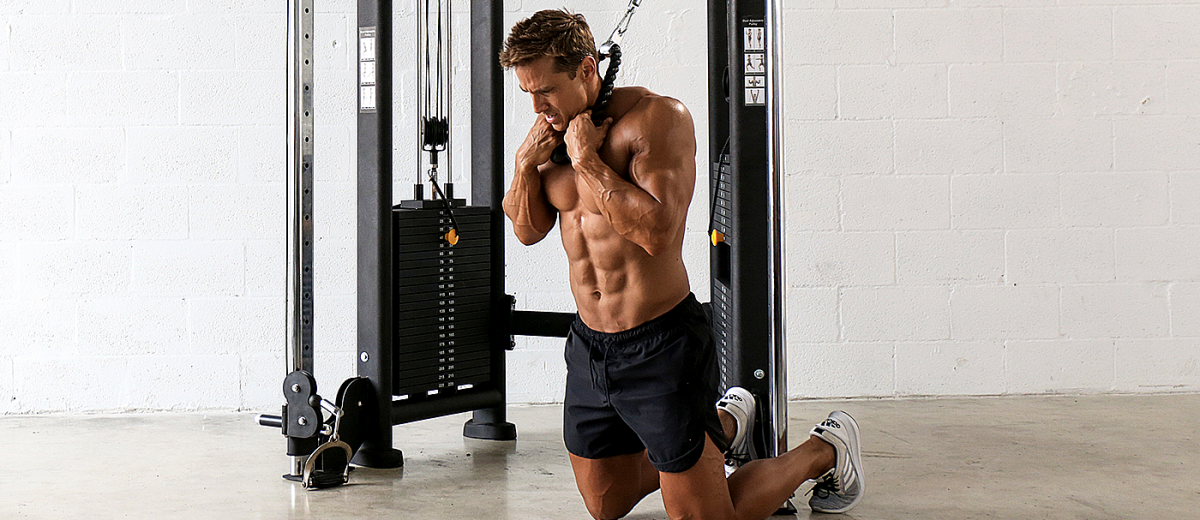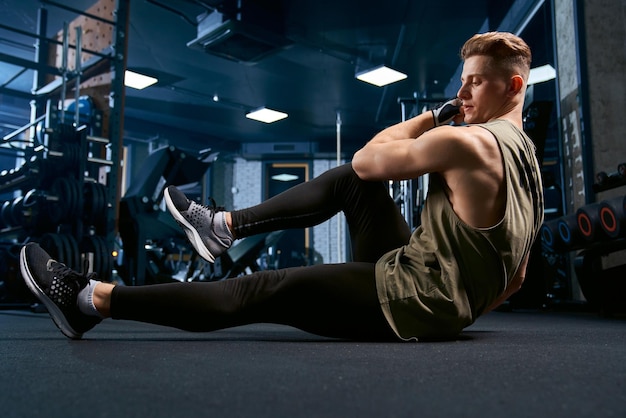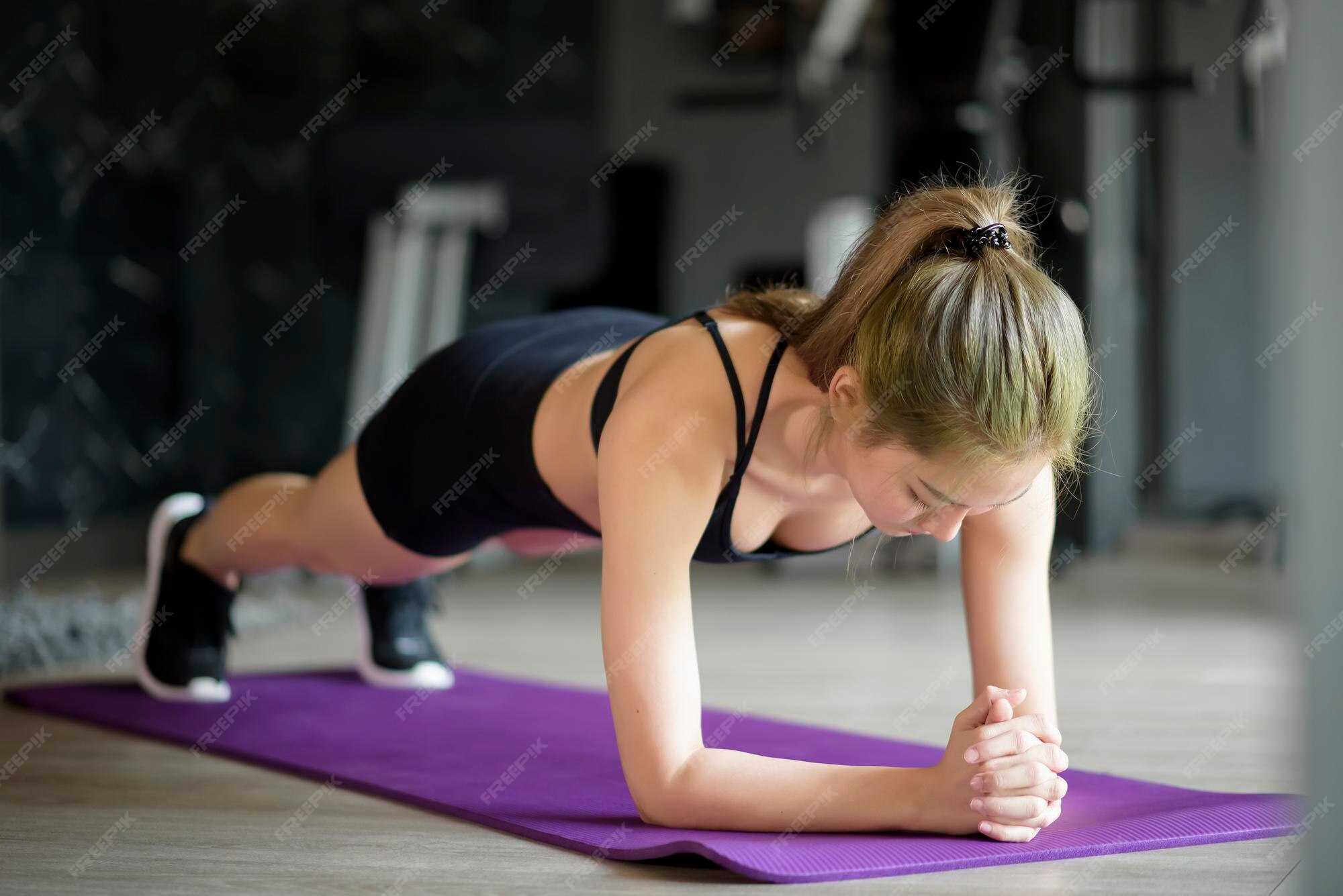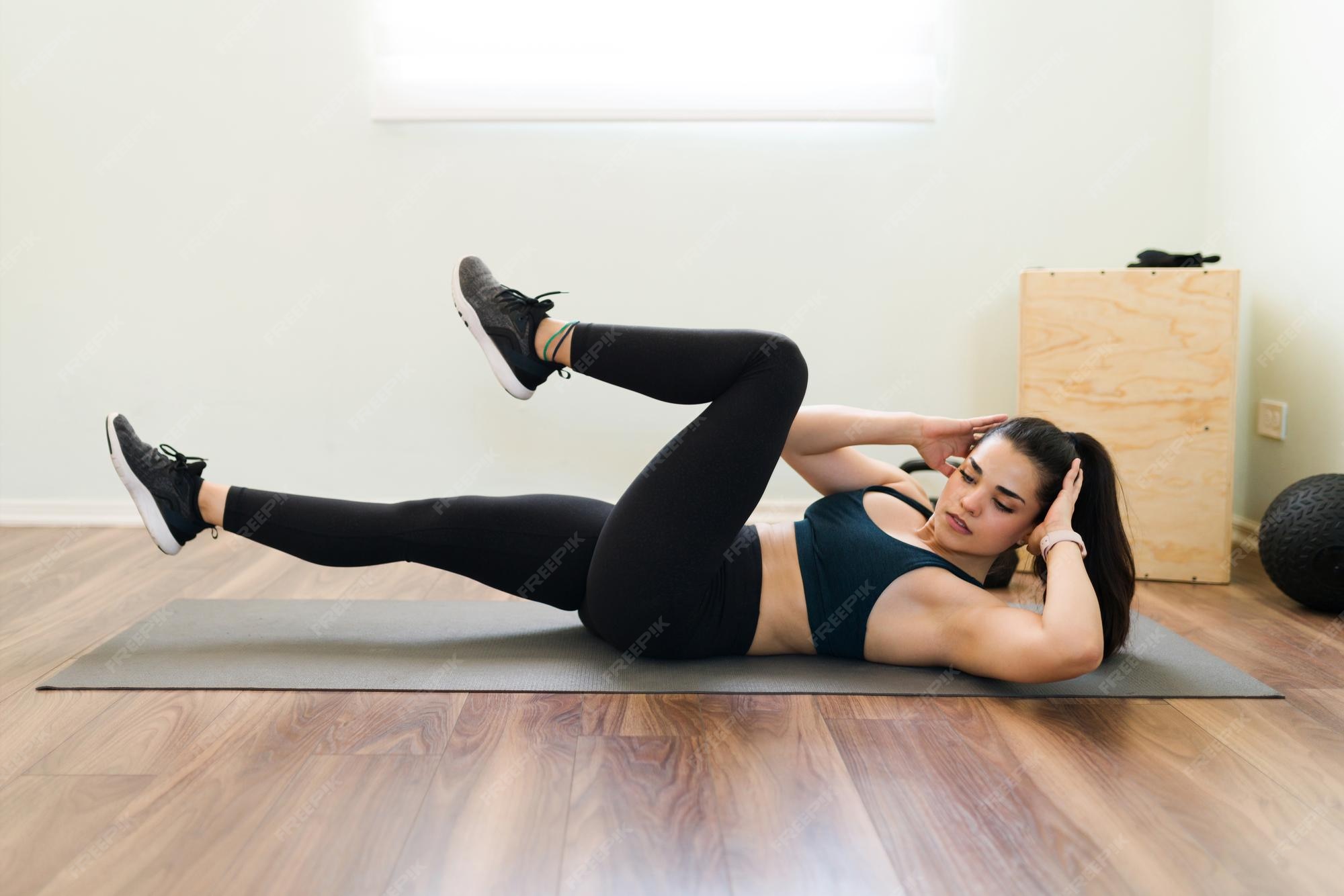Ab workout

There are many exercises you can do to target your abs and strengthen your core. Here are a few examples:
- Crunches: Lie on your back with your knees bent and feet flat on the ground. Place your hands behind your head and lift your head and shoulders off the ground, while contracting your abs. Lower back down and repeat for 10-15 reps.
- Plank: Get into a push-up position with your hands under your shoulders and your body straight from head to heels. Hold this position for 30-60 seconds, making sure to engage your core muscles.
- Bicycle crunches: Lie on your back with your hands behind your head and your legs lifted off the ground, bent at a 90-degree angle. Twist your upper body to bring your left elbow to your right knee while extending your left leg. Repeat on the other side and continue alternating for 10-15 reps.
- Russian twists: Sit on the ground with your knees bent and your feet flat on the ground. Lean back slightly and lift your feet off the ground, balancing on your tailbone. Twist your torso to the right and touch your hands to the ground beside your hip. Repeat on the other side and continue alternating for 10-15 reps.
Remember to breathe properly during each exercise and to focus on engaging your core muscles. It’s also important to vary your ab workout routine and include exercises that target different areas of your abs for optimal results.
Benefits of ab workout
An ab workout can provide a range of benefits, including:
- Improved core strength: Ab exercises target the muscles in your core, including your rectus abdominis, obliques, and transverse abdominis. Building strength in these muscles can improve your overall stability and balance, as well as support your spine and improve your posture.
- Better athletic performance: A strong core is essential for many physical activities, including running, jumping, and lifting weights. By improving your core strength, you may be able to perform better in your chosen sport or activity.
- Reduced risk of injury: A strong core can help prevent injuries to your back, hips, and other parts of your body. By providing support and stability to your spine, core muscles can reduce your risk of strains, sprains, and other types of injuries.
- Improved appearance: While having visible abs is not necessary for good health, a toned and defined midsection can be a desirable aesthetic goal for many people. By strengthening and toning your ab muscles, you may be able to achieve a leaner and more defined look.
- Better overall fitness: Ab exercises can be challenging and require a lot of energy and effort. By incorporating ab workouts into your fitness routine, you may be able to improve your overall fitness level and increase your endurance and stamina.
Crunches

Crunches are a classic ab exercise that target the rectus abdominis muscle, also known as the “six-pack muscle”. Here’s how to do them:
- Lie on your back with your knees bent and feet flat on the floor. Place your hands behind your head or across your chest.
- Tighten your abs and lift your head, neck, and shoulders off the ground, using your abdominal muscles. Your lower back should remain on the floor.
- Hold for a moment at the top of the movement, then slowly lower your upper body back down to the starting position.
- Repeat for the desired number of reps.
It’s important to avoid pulling on your neck with your hands, as this can strain your neck muscles. Instead, focus on using your abs to lift your upper body off the ground. You can also modify the exercise by placing your feet up on a bench or stability ball to increase the difficulty.
Plank

The plank is a great exercise for building core strength and stability. Here’s how to do it:
- Start in a push-up position with your arms straight and your hands directly under your shoulders. Your body should form a straight line from your head to your heels.
- Engage your abs and squeeze your glutes to keep your body in a straight line.
- Hold the position for 30-60 seconds, or as long as you can maintain good form.
- To come out of the plank, lower your knees to the ground and then rest in child’s pose or come to standing.
To make the plank easier, you can start by holding the position for a shorter amount of time, or by dropping down to your elbows instead of staying in a push-up position. To make the plank more challenging, you can try lifting one leg or arm off the ground, or placing your feet on a stability ball. It’s important to maintain good form throughout the exercise to avoid strain on your lower back or other areas of your body.
Bicycle crunches

Bicycle crunches are a great exercise for targeting multiple muscle groups in your core, including your rectus abdominis, obliques, and transverse abdominis. Here’s how to do them:
- Lie on your back with your hands behind your head and your elbows pointing out to the sides. Lift your feet off the ground and bend your knees to a 90-degree angle.
- Bring your right elbow towards your left knee while straightening your right leg, twisting your torso to the left.
- Switch sides, bringing your left elbow towards your right knee while straightening your left leg and twisting your torso to the right.
- Continue alternating sides, pedaling your legs in a bicycle motion while twisting your torso.
- Aim for 10-15 reps on each side, or as many as you can do while maintaining good form.
To avoid straining your neck, focus on keeping your chin lifted and your gaze towards the ceiling. Keep your lower back pressed into the ground to engage your transverse abdominis and protect your spine. You can also modify the exercise by placing your hands by your sides or crossing your arms over your chest.
Russian twists

Russian twists are a challenging exercise that target your obliques, transverse abdominis, and hip flexors. Here’s how to do them:
- Sit on the ground with your knees bent and your feet flat on the floor. Lean back slightly and lift your feet off the ground, balancing on your tailbone.
- Clasp your hands together in front of your chest or hold a weight or medicine ball.
- Twist your torso to the right, bringing your hands or weight to the ground beside your right hip.
- Twist back to the center and then to the left, bringing your hands or weight to the ground beside your left hip.
- Continue twisting from side to side, keeping your abs engaged and your feet lifted off the ground.
- Aim for 10-15 reps on each side, or as many as you can do while maintaining good form.
To avoid straining your neck or shoulders, keep your gaze straight ahead and your elbows close to your body. Focus on using your abs to twist your torso, rather than relying on momentum or swinging your arms. If lifting your feet off the ground is too challenging, you can keep your feet on the floor or place them on a bench for support.
When should avoid ab workout
While ab workouts can be beneficial for most people, there are some situations where you should avoid or modify your ab workout. These include:
- Recent abdominal surgery: If you have had abdominal surgery, it’s important to avoid ab exercises until you have fully healed and have received clearance from your doctor.
- Hernias: If you have a hernia, you should avoid exercises that put pressure on your abdominal muscles, as they can make the hernia worse. It’s important to consult with your doctor before doing any ab exercises if you have a hernia.
- Lower back pain: If you have lower back pain, certain ab exercises like crunches or sit-ups can exacerbate your pain. It’s important to modify your ab workout or avoid these exercises altogether until your pain has subsided.
- Pregnancy: While ab exercises can be safe for pregnant women, certain exercises like crunches or twisting movements can be uncomfortable or even harmful. It’s important to consult with your doctor or a qualified prenatal fitness specialist before doing any ab exercises during pregnancy.
- Pelvic floor dysfunction: If you have pelvic floor dysfunction, certain ab exercises can put pressure on your pelvic floor muscles and worsen your symptoms. It’s important to consult with your doctor or a qualified pelvic floor physical therapist before doing any ab exercises if you have pelvic floor dysfunction.
Keep in mind while ab workout
Here are some important things to keep in mind while doing an ab workout:
- Proper form: It’s important to maintain proper form while doing ab exercises to avoid injury and maximize the effectiveness of the exercise. Focus on engaging your core muscles and avoiding compensatory movements like using momentum or lifting your shoulders off the ground.
- Gradual progression: Don’t push yourself too hard too quickly, especially if you’re new to ab exercises. Gradually increase the intensity and duration of your workouts over time to avoid overuse injuries or muscle strains.
- Variety: Including a variety of different ab exercises in your workout can help prevent boredom and ensure that you’re targeting all the muscles in your core.
- Breathing: Don’t hold your breath while doing ab exercises. Breathe steadily and exhale as you contract your abs.
- Recovery: Allow your muscles time to recover between ab workouts. Overtraining can lead to muscle strains or other injuries.
- Consistency: Like any other workout routine, consistency is key to seeing results. Aim to do ab exercises 2-3 times per week and stick to your routine to see improvements in your core strength and overall fitness.
Summary
Ab workouts can provide a range of benefits, including improved core strength, better athletic performance, reduced risk of injury, improved appearance, and better overall fitness. However, there are certain situations where you should avoid or modify your ab workout, such as recent abdominal surgery, hernias, lower back pain, pregnancy, or pelvic floor dysfunction. It’s important to maintain proper form, gradually progress, include variety, focus on breathing, allow for recovery, and be consistent with your ab workout routine to see results.
The Site cannot and does not contain fitness, legal, medical/health, financial advice. The fitness, legal, medical/health, financial information is provided for general informational and educational purposes only and is not a substitute for professional advice. Accordingly, before taking any actions based upon such information, we encourage you to consult with the appropriate professionals. We do not provide any kind of fitness, legal, medical/health, financial advice. THE USE OR RELIANCE OF ANY INFORMATION CONTAINED ON THE SITE IS SOLELY AT YOUR OWN RISK.
DISCLAIMER

Average Rating